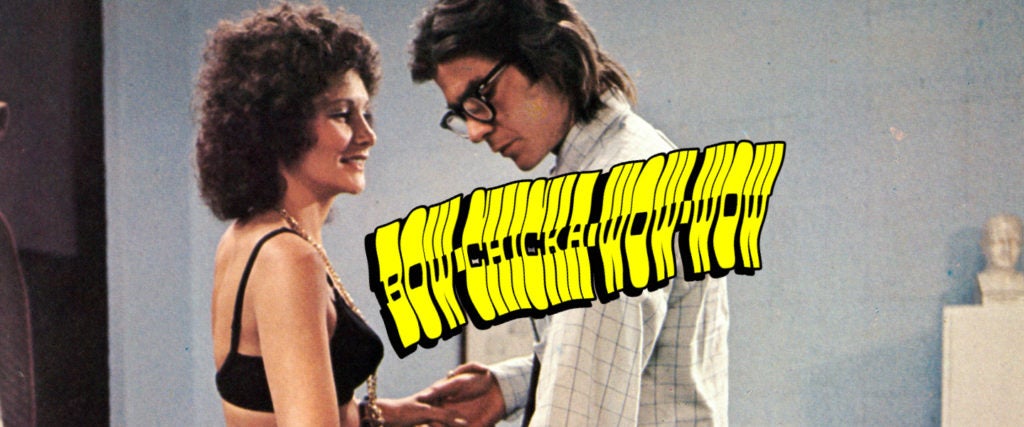Nothing says “it’s doin’ it time” quite like the opening licks of Marvin Gaye’s “Let’s Get It On.” There’s something sexy about wah-wah infused guitar — maybe the way it stretches the sound like a moan or feels both soulful and otherworldly at the same time. It’s a signature funk tone that moves through your entire body. One that, when imitated, goes a little something like this: “Bow-chicka-wow-wow.”
As any sexually active adult knows, that sound — essentially an onomatopoeia for the noise of strumming a guitar while stomping a wah-wah pedal — is synonymous with getting freaky. It’s even become the automatic, funk-based stand-in sound for sex. A ubiquitous shorthand that — among many, many, many other examples — has been used to promote the powers of Axe Body Spray (three times over), and served as the title of a horrifically bad Mike Posner song about “seduction.” (Even more cringe, country star Meghan Patrick’s attempt.)
How, though, did we get here? That is, why do we associate the funk-inspired “bow-chicka-wow-wow” not only with sex, but the entire canon of porn?
Well, for starters, considering one of funk’s most iconic songs is James’ Brown’s “Sex Machine,” sensuality is just a big theme in funk music. Blaxploitation films also helped cement the association between funk and sex because pretty much every movie featured both. Shaft is the undeniable standout of the genre, and who doesn’t hear the rolling rhythm of the hi-hat followed by a wave of groovy guitar from the titular song whenever the film is mentioned?
The lyrics are both sexually implicit (“Who’s the black private dick…”) and explicit (“…that’s a sex machine to all the chicks?”), and they prepare us to experience Shaft — a guy who’s gonna get laid a lot in the next hour and forty minutes.
But Shaft isn’t porn. It wasn’t the first Blaxploitation film, either. Three months before Shaft’s release in 1971, Sweet Sweetback’s Baadasssss Song dropped. This was one of the first movies to demonstrate that Black militancy and urban life could be profitable stories — and some scholars have argued that it is porn. The story centers on a boy raised in a brothel who grows up to have a huge dick, and between car chases and police showdowns, there’s so much sex — the real kind, not the simulated stuff — that it received an X-rating. And it’s all set to a gospel-tinged funk soundtrack with helpings of — you guessed it — “bow-chicka-wow-wow.”
Aligning Sweet Sweetback with Blaxploitation over porn has likely afforded it closer critical inspection. But in the book Blaxploitation Films, scholar Mikel J. Koven argues this is a mistake. “The film is more pornography than Blaxploitation,” he writes. “Conventional wisdom … likes to note that the film’s box-office success indicates that it spoke to a contemporary Black audience. [But] it strikes me that the $1.5 million it made domestically was due more to curiosity about the sex in the film, than an engagement with the socio-politics of it.” (An obvious questions, of course, but why couldn’t people be interested in both?)
To sell the movie, director Melvin Van Peebles advertised it as “rated X by an all-white jury.” This banked on an understanding that Black sexuality is held to closer scrutiny, and the legacy of Sweet Sweetback and similar movies’ soundtracks may be proof. Van Peebles didn’t have money for a composer, but his secretary was dating a member of the then-unknown group Earth, Wind & Fire, so he worked out the music’s basic feeling for the band, before recording them playing as he projected the film in their apartment.
There are ecstatic keyboards, groove drumming, saxophones and wailing guitar — early audible expressions of what would later get watered down to become porno funk cliches. But again, Sweet Sweetback was a groundbreaking film because it was made by Black people about Black experiences and fantasies. So despite its sex and soundtrack, it’s mostly remembered as an exploration of Black masculinity and revolution, not an erotic movie — or the soundtrack to one.
You know what is remembered that way, though? Deep Throat. It came out a year later, but it’s often cited as porn’s breakout moment because it paired sex with higher production values, a cogent plot and a super-memorable soundtrack. (Sound familiar?) This brought on-screen sex closer to the mainstream than it’d gotten. When writing about the film in his mid-century survey, soundtrack historian Kristopher Spencer explains, “Instead of wall-to-wall porno funk, one gets some surprisingly memorable melodies, occasional passages that convey a genuine cinematic mood, [and] competent musicianship by anonymous musicians.”
Even as a supposed expert, Spencer takes porno funk for granted pre-Deep Throat by suggesting the movie’s lack of funk is a welcome departure. He also implies funk musicians are incompetent while ignoring the occasional whiffs of deep funk on Deep Throat’s soundtrack. (Alex, what is racism?)
For a better answer then, I took the question to April Hall, one of the brains behind the Rialto Report and a consultant for HBO’s The Deuce. “It’s an interesting question as there have been so many musical styles used in porn films — everything from classical music ‘borrowed’ by early filmmakers like John Amero to scores from European composers like those commissioned by Radley Metzger to original pop songs sung by Linda November, queen of commercial jingles in the 1960s to 1980s,” Hall writes over email. “As to why the music is so defining, the fans of the films hold the answer. Many of them describe in painstaking detail and with great nostalgia the tunes that embedded in their brains during their formative sexual viewing.”
In short, there can be a popular idea of what porn “sounds” like — or at least, what we think it did at one time — as well as a deeply personal one. However, gay porn complicates things further. Gay film historian Evan Purchall, who recently released the archival porn montage movie Ask Any Buddy, explains that mainstream porn — i.e., straight porn — operated like a “shadow Hollywood,” but that gay porn had its own musical conventions.
“There was a lot of money being put into [straight porns of the 1970s],” he says, “A lot of people seeing them. So the filmmakers would use library tracks or private musicians to compose original scores. The gay side was like Poverty Row, and very low-budget. The filmmakers knew that people would never admit to seeing these movies, so they had no problem stealing whatever music they wanted. You’ll hear The Beatles, Pink Floyd, a lot of disco, even Steve Reich.”
One thing was true of both, however: They often tapped whoever was closest for soundtracks. This could include family members as much as studio musicians and composers. For example, director Alfred Sole recruited his 16-year-old nephew’s band to score his 1972 movie Deep Sleep. In gay porn, this could be an aspiring musician friend who went uncredited. “Basically, it was who you knew, who knew you and how much you enjoyed sex films,” Hall explains.
But for straight porn, soundtracking became increasingly professionalized. In the late 1970s, erotic cinema was lucrative enough to attract big-budget composers, who’d often work under pseudonyms to maintain facades of professional respectability. By the mid-1980s, though, some people started parlaying porn soundtrack work into mainstream Hollywood opportunities under their own names. Especially fascinating is Mitchell Froom, who started out doing unsettling synth-y scores for horror porns and ended up working with artists like Bob Dylan and Sheryl Crow.
It’s a little unclear exactly when funk got absorbed into porn soundtracking. With few exceptions, it didn’t seem to be happening much in the 1970s and 1980s — definitely not enough to be a hallmark of adult movies. But by the late 1990s, the once-vibrant Black 1970s sound had been neutered for white, cable-ready softcore. In an article for Salon, lounge musician Brother Cleve recalls working at Cinemax during that time. “I saw some of the late-night ‘Skinemax’ films, and they had scores by people who were undoubtedly using assumed names,” he explains. “The sound was ‘wah-wah funk’ in the sort of Blaxploitation style.”
Cultural appropriation is probably the biggest reason why this happened. But even though, as mentioned earlier, most Blaxploitation movies aren’t considered porn, nudie magazines and porn industry periodicals of the 1970s would still often review them, especially ones featuring pimps and sex workers like Trick Baby, which was adapted from a novel by a real-life pimp. (It’s also worth noting that there was one clear-cut Blaxploitation porno — 1974’s Lialeh, featuring a soundtrack by Aretha Franklin’s musical director.)
These publications would also advertise the albums of comedians like Richard Pryor, whose material included sexual candor as much as anti-police jokes and frank discussions of race. Some of these records included funk music, too. Thus, funk didn’t need to be in porn to be on the radars of its most avid consumers. It was an aural signal of things outside mainstream acceptability, including explicit sex.
Moreover, funk music itself shifted in the late 1970s. In his book Funk: The Music, the People and the Rhythm of the One, music historian Rickey Vincent argues Black music in general went from being sexually implicit to explicit, pointing to Donna Summer’s orgasmic “Love to Love You Baby” as “a symbolic demolition of the age-old Black musical tradition of innuendo: teasing, implying and anticipating the sexual experience as a means of enriching it.”
Summers was coaxed to whisper and moan through the song (what one reviewer described as “a marathon of orgasms”) by her white producer. Vincent suggests this is emblematic of a larger phenomenon that still happens today: Black music orchestrated by white executives for white audiences, who demand hearing Black musicians express sexual availability. “Black music was now out of control of its practitioners,” Vincent writes.
Fast forward 20 years, and all these factors contribute to someone saying, “I know what would make a great soundtrack for this blonde getting plowed in a hot tub…”
Of course, the goofy groove known as porno funk has never approximated the build-up of desire that’s the hallmark of classic 1970s funk. So while our TVs may have cheesed out “bow-chicka-wow-wow,” but our bedrooms will always have Marvin Gaye.

